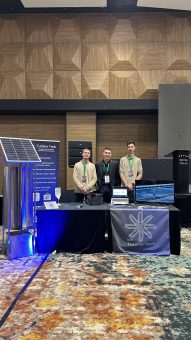Technological innovation can significantly enhance the efficiency and accessibility of renewable energy sources, making them more competitive with traditional energy systems. Developing new solutions enables greater integration of renewables into existing energy grids, contributing to global efforts to reduce CO2 emissions and combat climate change.

Demonstrating that youth can be drivers of change in renewable energy and the fight against climate change is the Turbine Tech team from Sarajevo, led by eighteen-year-old Muhamed Hamamdžić. This team won the Best Technical and Engineering Project award at the “Made in BiH 2024” ceremony held in January.
“Turbine Tech is a project I started a year ago to develop advanced technologies in the field of renewable energy, particularly vertical wind turbines and IoT devices for monitoring and managing energy systems. I was inspired by Emerik Blum, who laid the foundations for the idea that Sarajevo—and the whole of Bosnia and Herzegovina—must invest more in energy and renewables. His vision showed that we have immense potential in this sector, which motivated me to contribute to developing new technologies that can shape the future of our energy infrastructure,” explains Hamamdžić.
He further elaborates that the Savonius turbine is a type of vertical-axis wind turbine that uses aerodynamic drag, not lift, to generate energy. Its advantages over conventional horizontal turbines are numerous—from efficient operation at low wind speeds, quieter performance, all-directional functionality, to lower maintenance costs.
IN FOCUS:
- Technological Breakthrough In the Fight Against Wildfires
- Low Development of E-Mobility in Bosnia and Herzegovina
- Slovenian E-Mobility Solutions Conquering the World
“Savonius turbines are ideal for both urban and rural environments with weaker winds, where traditional turbines are ineffective. These turbines operate much more quietly, making them suitable for installation near residential areas. They do not require additional mechanisms to orient towards the wind. Due to their simple mechanical design, they demand less maintenance,” says Hamamdžić.
Savonius turbines are especially useful for decentralized energy systems and can power homes, farms, campsites, and even industrial facilities.
The Potential of BiH
Bosnia and Herzegovina has significant potential for developing vertical-axis wind turbines, particularly in regions with lower wind speeds where conventional turbines prove inefficient.
“Our country also has many rural areas without stable energy infrastructure, where Savonius turbines could play a key role,” the young innovator explains.
The Turbine Tech project has been presented at several technical fairs and competitions, receiving overwhelmingly positive feedback.
“Engineers in renewable energy and potential investors have shown great interest, which is a huge motivation for me to keep going. The production cost of a single 5-kilowatt Savonius turbine is around €1,500, which is significantly cheaper than conventional horizontal turbines of the same capacity,” says Hamamdžić.
Although the team currently has no official investors, Hamamdžić notes that the cost of building a small wind farm using Savonius turbines ranges between €10,000 and €80,000, depending on the number of installed units. The advantage, he adds, is that such a system is far more accessible than large wind farms.
Prepared by Jasna Dragojević
Read the story in the new issue of the Energy portal Magazine SUSTAINABLE MOBILITY

